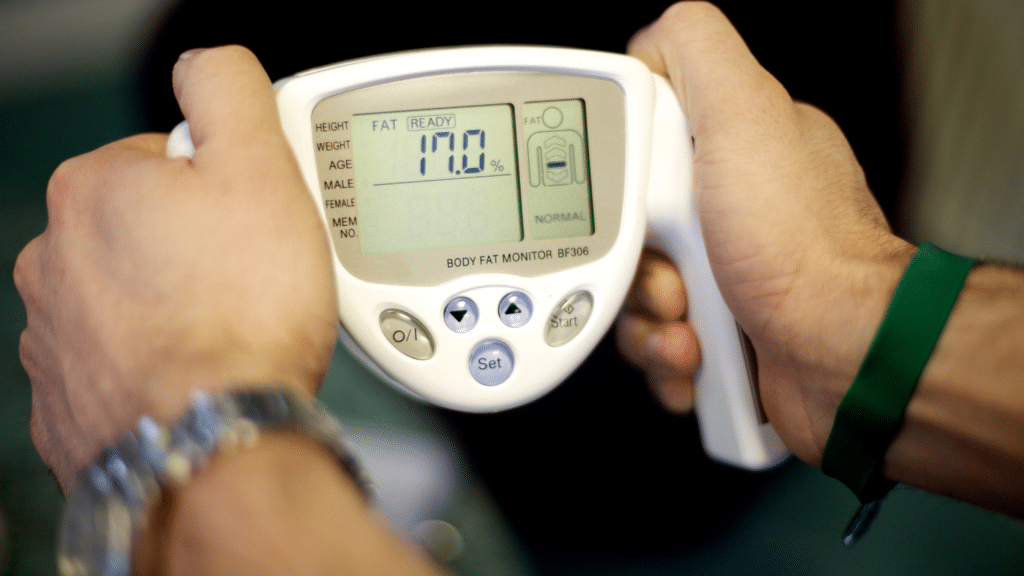Word: This text was the MASS Analysis Overview cowl story for January 2024 and is a part of their “From the Mailbag” collection of articles. In order for you extra content material like this, subscribe to MASS.
This text isn’t concerning the precise query listed above. In actuality, it’s about a complete style of questions that contain making an attempt to succeed in a selected body-fat share inside a selected (and sometimes very quick) time-frame. I’ve answered this query numerous instances all through my health profession, and the one that asks the query is just about by no means glad by my response. The reality is, I’m usually essential of this query as a result of I’m essential of the goal-setting course of it displays. I by no means set a selected body-fat share because the purpose of a weight-reduction plan or program, and I favor to make the most of versatile timelines quite than a selected deadline for purpose completion (each time doable). On this article, I’ll clarify why body-fat targets with mounted timelines are inadvisable and provide a greater various.
No person Cares What Your Physique-Fats Share Is
My first subject with making a selected body-fat share your purpose is expounded to logical reasoning quite than empirical scientific information. Merely put, no one cares what your body-fat share is (together with you, most definitely). In my expertise, body-fat targets are (at greatest) proxies which can be believed to be roughly appropriate with the true purpose. For instance, somebody may need to get down to twenty% body-fat as a result of their most up-to-date blood exams revealed excessive ldl cholesterol and impaired glycemic management. They could assume that they will get these blood biomarkers in verify in the event that they’re in a position to get down to twenty% body-fat, which can certainly be true. Nonetheless, their purpose isn’t really the body-fat share; in the event that they received to twenty% body-fat and nonetheless had excessive ldl cholesterol and impaired glycemic management, they wouldn’t have achieved the precise endpoints they had been actually hoping for.
Typically folks will set body-fat targets as a result of they imagine it’ll enhance their athletic efficiency. For instance, a powerlifter may imagine they’d be extra aggressive in a decrease weight class, or an athlete may imagine they’d be extra explosive if that they had a extra favorable strength-to-mass or power-to-mass ratio. These of us may assume that their athletic targets can be taken care of in the event that they reached their meant body-fat stage, however body-fat share is as soon as once more a poor proxy on this state of affairs. If a powerlifter received all the way down to their purpose body-fat share, competed in a decrease weight class, however ended up performing poorly and inserting worse, I doubt they’d be glad with that set of outcomes.
Typically folks will set body-fat targets as a result of they imagine it’ll assist them obtain a specific aesthetic look. For instance, somebody may see a health mannequin or bodybuilding competitor with a fascinating physique, estimate that particular person’s body-fat share, then got down to attain that exact same body-fat share. The most typical approaches for visually estimating somebody’s body-fat share are both guessing or utilizing a three-by-three grid of photographs with estimated body-fat ranges. Right here’s the issue: physique fats distribution varies from individual to individual, and the visible influence of muscular definition relies on the mixed results of subcutaneous fats storage and underlying muscular improvement. So, think about you estimated the body-fat share of a health mannequin and used that as your purpose. Would you be glad in case you achieved that body-fat share however regarded completely completely different as a consequence of inadequate muscularity? Alternatively, would you be glad in case you achieved that body-fat share however ended up with completely shredded limbs whereas retaining appreciable fats in your belly part? The satisfaction that comes from reaching targets is very subjective, however normally, these hypothetical situations will result in extra disappointment than satisfaction. Even in aggressive bodybuilding, the place fixation on body-fat share values is rampant amongst rivals, emphasis on particular body-fat values is misplaced. The leanest bodybuilder doesn’t at all times win, and judges won’t ever ask, measure, or know your body-fat share. The purpose of a aggressive bodybuilder is to attain a sure look that balances muscularity, symmetry, and leanness – it’s laborious to win a present with excessive body-fat, however rivals are higher served by specializing in their total physique and presentation as a substitute of focusing solely on an arbitrary body-fat share purpose.
So, in case your purpose is to enhance a health-related metric, set a purpose for that health-related metric. In case your purpose is to enhance efficiency, set a efficiency purpose. In case your purpose is to look a sure approach, set an appearance-oriented purpose. In all three situations, body-fat share is merely a proxy for the true underlying purpose, and a poor proxy at that.
No person Is aware of What Your Physique-Fats Share Is
Let’s assume you skimmed the final part, rejected the premise completely, and set a purpose to attain a selected body-fat share. How would you really know in case you reached your purpose?
The obvious reply is that you just’d get your body-fat share measured. In actuality, it is a surprisingly insufficient reply. Physique-fat measurement is categorically off the desk; the one strategy to actually measure physique fats is cadaver dissection, and that looks like a reasonably excessive option to me. As a substitute, there are numerous widespread strategies for estimating body-fat share. The traditional estimation strategies are underwater weighing and skinfold measurements utilizing calipers. Extra fashionable estimation strategies embody bioelectrical impedance evaluation, air displacement plethysmography (BodPod), three-dimensional optical scanners, ultrasound imaging, and dual-energy x-ray absorptiometry (DXA). Intuitively, most individuals appear fairly snug assuming that underwater weighing and skinfold measurements are imperfect strategies topic to significant estimation error. Individuals are inclined to naturally assume that older strategies are much less correct (in the event that they weren’t, why would we trouble to create newer strategies?), and it appears fairly far-fetched to imagine that figuring out the thickness of skinfolds at a number of particular websites or figuring out your body weight in a pool will yield a particularly exact body-fat worth. Then again, folks are inclined to naturally assume that newer strategies are very correct, particularly in the event that they contain tools that’s costly and technologically spectacular. So, do newer estimation strategies like BodPod, DXA, and bioelectrical impedance evaluation give us exact estimates?
Sadly they don’t. For instance, a cross-sectional research printed in 2004 estimated the body-fat share of 27 male bodybuilders (1). They used a wide range of estimation strategies together with underwater weighing, deuterium dilution, dual-energy x-ray absorptiometry, prediction equations primarily based on physique mass index, skinfold measurement, bioelectrical impedance, a three-compartment mannequin incorporating complete physique water, and a three-compartment mannequin incorporating bone mineral content material. These strategies had been in comparison with a four-compartment mannequin, which served because the “gold commonplace” for comparability functions. The outcomes of those estimation strategies are introduced in Determine 1.
Wanting on the extensive error bars in Determine 1, you’ll be able to see that it isn’t notably uncommon for widespread body-fat estimations to overestimate or underestimate body-fat by a number of factors. For instance, the error bars for DXA span from roughly +6 to -5. Think about your purpose was to chop from 15% body-fat to 10% body-fat – a reasonably typical fluctuation for somebody transitioning from the tip of a winter bulk to a manageable lower for the summer season months. It’s not completely implausible to think about a state of affairs the place DXA underestimates your body-fat by 5 factors firstly of the lower, and overestimates your body-fat by 5 factors on the finish of the lower. You possibly can absolutely obtain the purpose, whereas your body-fat estimates would mirror no change in body-fat share (regardless of a considerable drop in physique mass). In different phrases, you probably did precisely what you got down to do, however DXA would counsel that you just had been shedding lean mass at an alarming price. After all, the other may additionally happen – if DXA overestimated your body-fat by 5 factors firstly of the lower and underestimated your body-fat by 5 factors on the finish of the lower, you’d be satisfied that your lower was dramatically extra profitable than it actually was. To be truthful, Determine 1 isn’t all dangerous information for physique composition estimation. When you have a look at the common worth for every estimation technique, they carried out fairly effectively on the group stage. They overestimated some folks, underestimated some folks, however total offered a reasonably good estimate of the group-level common. This determine demonstrates why these physique composition estimation strategies are implausible for assessing group-level averages in analysis, however insufficient for exact estimates on the particular person stage.
The information introduced in Determine 1 may be convincing to some, however I’m positive there are folks questioning about two particular particulars: how may these information search for non-bodybuilders, and what do the person information factors really appear like? To deal with each issues, Determine 2 shows some information that I introduced again in 2017 (2). We estimated body-fat share values in 34 adults with chubby or weight problems utilizing BodPod, DXA, and ultrasound, and in contrast these values to a gold commonplace four-compartment estimate. Determine 2 exhibits three completely different Bland-Altman plots, which every visualize the extent of settlement between two of the measurement units. For instance, the primary plot in Determine 2 is labeled “DXA.” The x-axis values are the “common” body-fat estimate obtained from DXA and the measure it’s being in comparison with (the “gold commonplace” four-compartment mannequin). In different phrases, you estimate body-fat by way of DXA, estimate body-fat by way of the four-compartment mannequin, and take the common of the 2 to acquire the x-value. The y-value is the distinction between the 2 estimation strategies. The bigger the distinction, the decrease the extent of settlement between the 2 measurement strategies. The skinny daring line in every determine represents the common distinction, and the dashed strains characterize the 95% limits of settlement. The 95% limits of settlement are roughly two commonplace deviations above and beneath the imply distinction, and will usually include about 95% of the distinction values for 95 p.c of future measurement pairs.
Determine 2, we see that the group-level common estimates had been fairly good, however individual-level estimates revealed appreciable error. Whereas BodPod carried out surprisingly effectively, some DXA values underestimated body-fat by as much as 5 share factors or overestimated body-fat by as much as 10 share factors. For somebody who’s adamant to find out in the event that they’re 10% body-fat or 12% body-fat, that’s not notably useful. If a body-fat estimation technique is merely going to get you inside a believable vary (plus or minus a number of share factors), you’ll be able to most likely guess what that vary is earlier than you even get examined.
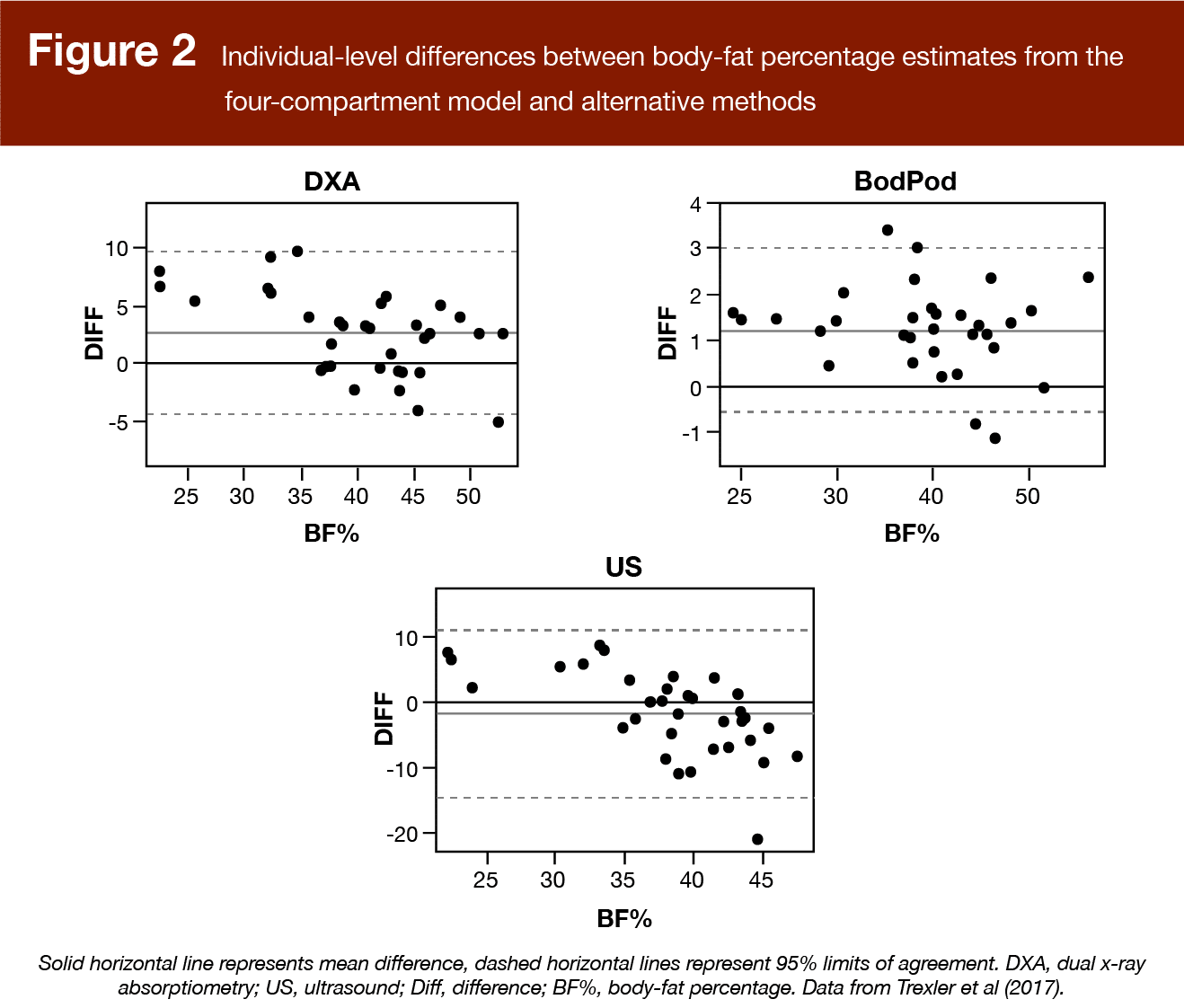
At any time when these limitations of body-fat estimation are mentioned, a pure follow-up query involves thoughts: baseline body-fat estimates could also be a bit off-base, however can’t we use these strategies and units to trace body-fat adjustments over time? When monitoring group-level averages, widespread body-fat estimation strategies are inclined to do fairly effectively. Nonetheless, the magnitude of error stays a bit too giant to lean closely on these strategies for longitudinal monitoring of individual-level body-fat adjustments. Within the beforehand talked about research by van Marken Lichtenbelt et al, 15 of the 29 bodybuilders participated in a longitudinal intervention the place adjustments in physique composition had been assessed over time. The group-level variations amongst estimation strategies are introduced in Determine 3. In our beforehand talked about research, we’ve 15 pairs of pre-test and post-test values following intervals of considerable (≥4.5kg) weight reduction. The person-level variations amongst estimation strategies are introduced in Determine 4. In these figures we see extensive error bars, extensive limits of settlement, and appreciable individual-level error when evaluating numerous estimation strategies to the four-compartment mannequin.
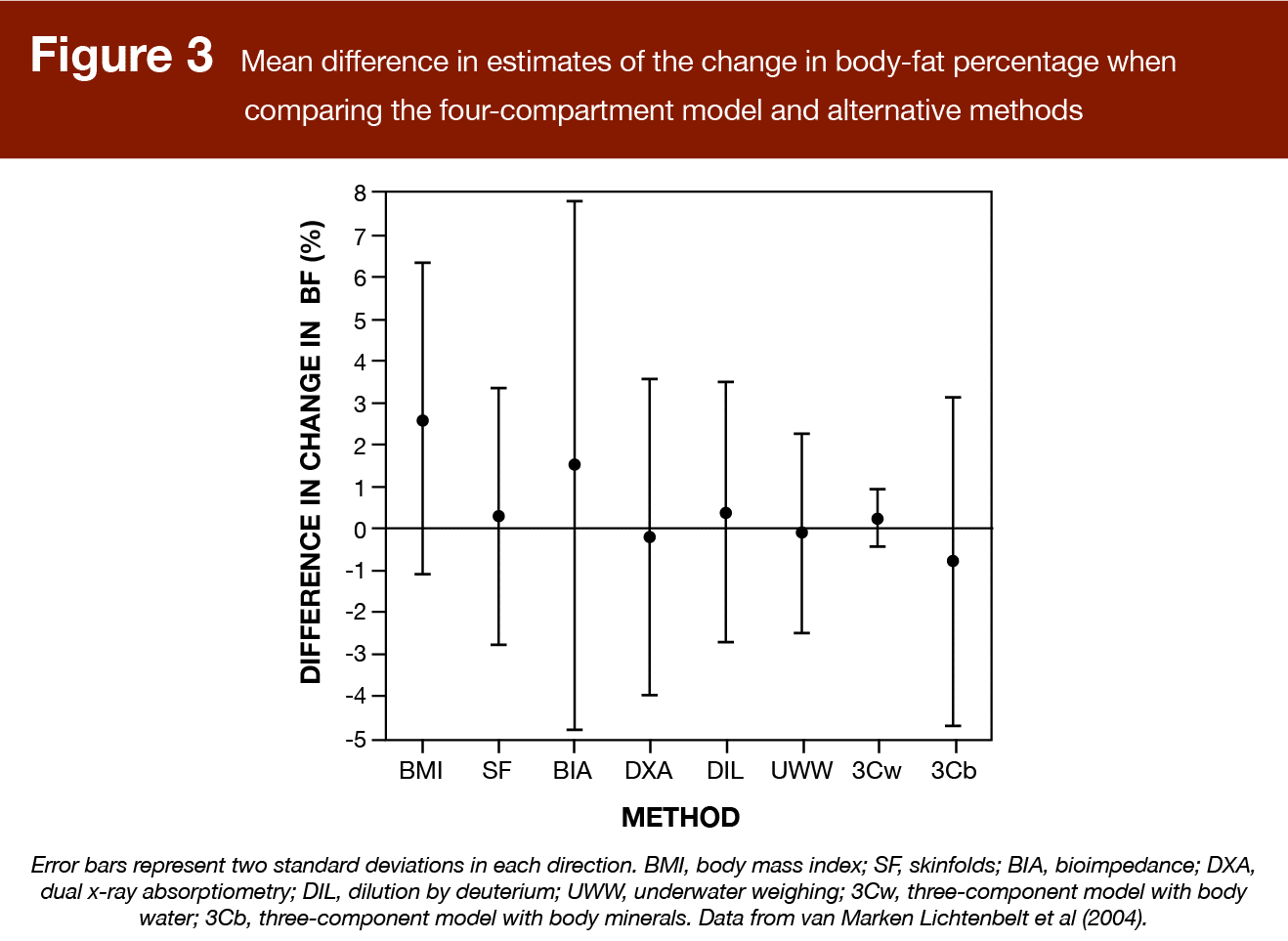
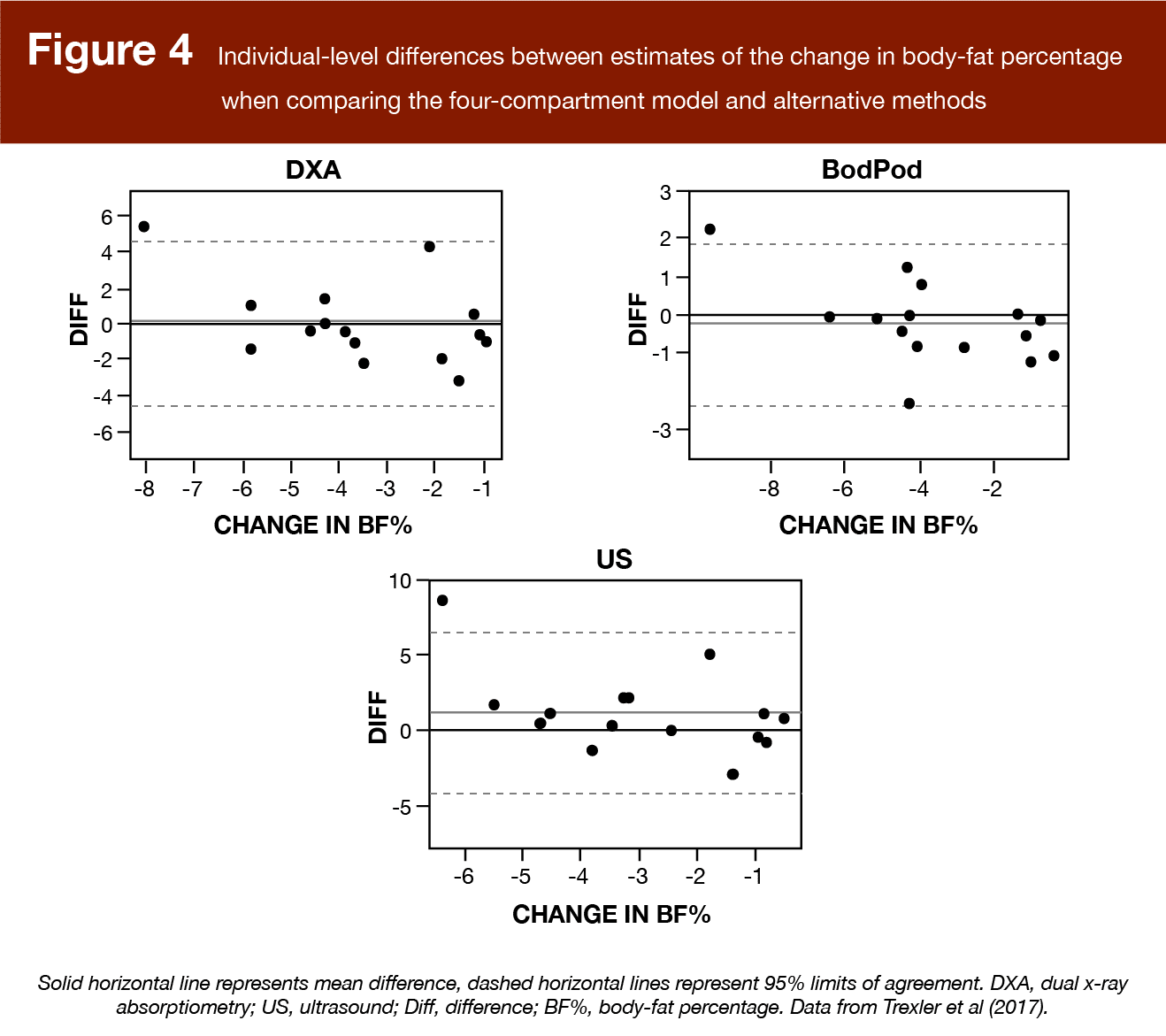
So, even in case you actually do care about your body-fat share and have entry to research-grade estimation strategies, you received’t really know the place you began, the place you ended, or how a lot body-fat you misplaced alongside the way in which. From my perspective, setting a purpose with a really particular quantitative endpoint that may’t be confidently confirmed or verified is difficult to justify.
It’s Troublesome to Predict Adjustments in Fats-Free Mass
Let’s ignore the technicalities of measurement for some time and deal with a sensible drawback. One of many extra widespread questions I get on Instagram goes one thing like this: “I’m at the moment 15% body-fat and I need to lower all the way down to 10% body-fat. How a lot weight will I have to lose to get there, and the way lengthy will that take?”
Even with a superbly correct estimate of your baseline body-fat share (which we by no means have), I’ve no satisfying reply to this query. Broadly talking, your probability of shedding, sustaining, and even gaining lean mass throughout a lower may very well be dependent upon your coaching standing, your genetic predisposition to muscularity, your non-lifting bodily exercise habits, the effectiveness of your coaching program, and dietary components together with protein consumption and caloric consumption. Now we have sufficient data to set common expectations for adjustments in lean mass throughout weight reduction. For instance, learners are way more more likely to acquire muscle whereas shedding pounds. We even have sufficient data to information greatest practices on the subject of sustaining (or gaining) lean mass throughout weight reduction. For instance, you undoubtedly don’t need to skimp on protein (3), and also you don’t need to implement a large caloric deficit (4). As proven in Determine 5, giant deficits are way more more likely to drive the loss of lean mass compared to extra modest caloric deficits (4). You’d additionally need to keep away from extraordinarily excessive volumes and frequencies of cardio; whereas the interference impact is commonly overstated on the subject of hypertrophy or muscle retention, extraordinarily excessive doses of cardio can certainly intervene with the accretion or retention of lean mass (5).
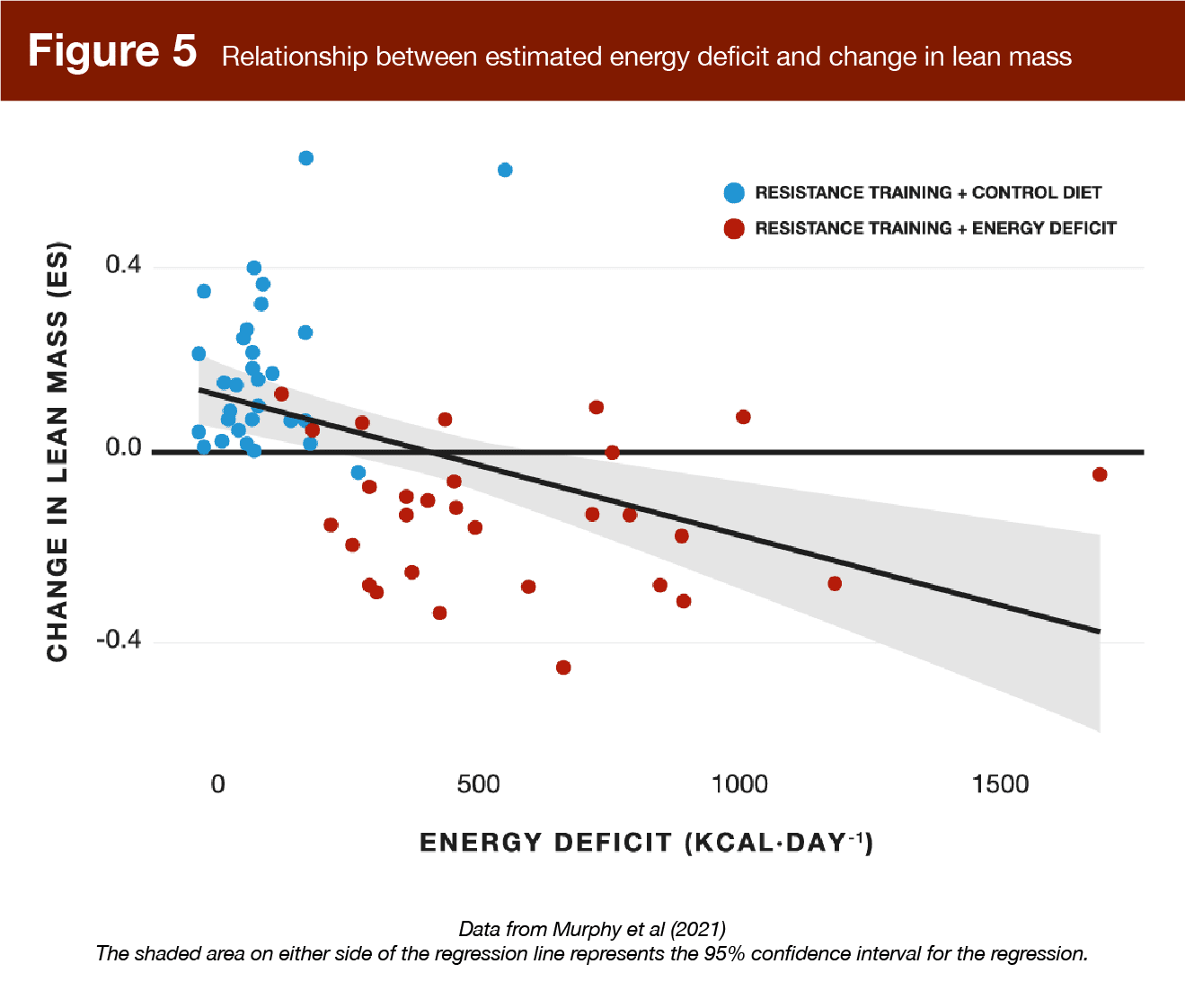
If we need to take a extra granular strategy to forecasting adjustments in lean mass, we must always most likely consider coaching standing and particular coaching variables on a muscle-by-muscle foundation. For instance, it’s fairly widespread for lifters to focus solely on upper-body muscularity early of their lifting profession earlier than finally getting severe about lower-body coaching. There are many well-trained lifters with distinctive upper-body improvement who’re primed to make “newbie features” after they begin allocating equal consideration to their lower-body musculature. Alongside related strains, accidents are nearly inevitable in case you follow lifting for lengthy sufficient, whether or not these accidents happen within the gymnasium or elsewhere. Nearly each lifter will expertise intervals of detraining in response to accidents, and so they’re more likely to expertise rapid gains after they’re in a position to resume regular coaching for the affected muscle group(s). In the case of coaching standing, we regularly prefer to broadly categorize folks as being a newbie, intermediate, or superior. Nonetheless, this overly simplistic strategy fails to account for the truth that your numerous muscle teams might have various levels of hypertrophy potential over the following a number of weeks as a result of construction of your future coaching program and the coaching program you’ve been following for the previous few months.
You possibly can solely assess the suitability of a purpose to succeed in a selected body-fat share by a deadline in case you can precisely predict how lean mass will change through the goal-striving course of. That prediction will be very troublesome to make with a excessive stage of accuracy, as longitudinal lean mass adjustments for every particular person muscle group can be dictated by a variety of things and genetic predisposition will range from individual to individual. For very bold weight reduction targets, it’s additionally doubtless that the fraction of weight misplaced as lean mass will range over time (usually rising as you get leaner). The quantity of lean mass you acquire or lose will influence the quantity of weight you must lose as a way to attain your goal body-fat share, and the quantity of weight you must lose will influence the timeline of your fats loss plan. If you wish to understand how lengthy it’ll (or ought to) take to succeed in a selected body-fat share, I have to predict precisely how a lot lean mass you may acquire or lose through the course of. If I’ve been teaching you for some time, I’ll have a reasonably good thought; in case you’re simply DMing me on instagram out of the blue, I can’t make that prediction with excessive confidence. I’d have to ask you a really lengthy checklist of questions, make a number of semi-informed assumptions, then make an uninformed guess about your genetic predisposition for muscle development and retention.
Fastened Deadlines Might Encourage Unsustainable Strategies, Inflexible Cognitive Restraint, and Extreme Give attention to Outcomes Over Processes
By setting a time-capped purpose to realize a specific body-fat share by a given deadline, you’ve created a mission with two doable outcomes: go or fail. You both attain the goal body-fat share by the deadline otherwise you don’t. This sort of purpose can feed into inflexible cognitive restraint, which has been mentioned many instances earlier than in MASS content material (one, two). Inflexible restraint is characterised by setting rigid guidelines and bounds, and somebody using inflexible cognitive restraint will usually consider their progress in dichotomous phrases (success or failure, with no grey space). For targets pertaining to weight-reduction plan and fats loss, inflexible dietary restraint is related to a variety of unfavourable outcomes, together with disordered consuming behaviors and attitudes, physique picture considerations, psychological misery, and poorer well-being (6). Inflexible restraint is contrasted by versatile cognitive restraint, which includes a way more versatile strategy to striving towards targets and assessing one’s progress. Reasonably than getting upset about failing to succeed in a selected body-fat share by a given date, somebody implementing versatile cognitive restraint would as a substitute acknowledge the partial success they skilled by getting near their purpose and shift their sights towards persevering with their trajectory of profitable purpose striving. Unsurprisingly, versatile cognitive restraint throughout purpose striving is related to higher psychological outcomes, total well-being, and long-term purpose attainment when in comparison with inflexible restraint (6).
Now, let’s say your purpose was to succeed in 10% body-fat within the subsequent eight weeks. Over that eight week interval, you estimated that you just’d have to lose 12 kilos of fats. It’s now been 4 weeks, and also you’ve solely misplaced 3 kilos of fats. What do you do now?
In accordance with your purpose, you must push approach more durable – you’re not on tempo to hit your goal body-fat share by the deadline, so you must crank into a better gear. That doesn’t make very a lot sense in my view. Your purpose was to lose 6 kilos within the first 4 weeks, however regardless of your greatest efforts, you fell 3 kilos quick. It’s laborious to justify the search to lose 9 kilos within the subsequent 4 weeks, given the truth that you had been unable to lose even 6 kilos within the earlier 4 weeks. Time-capped targets counsel that you must paradoxically make your purpose more durable whenever you’re struggling probably the most, which doesn’t make sense – you might be least outfitted to extend your goal price of weight reduction whenever you’re already falling in need of it. This will likely result in unsustainable crash-dieting techniques that contain excessive short-term sacrifices to succeed in the predetermined body-fat purpose “on time,” which doesn’t bode effectively for long-term success and well-being.
This highlights yet one more drawback with setting body-fat share targets with mounted deadlines. They’re, by definition, outcome-oriented (quite than process-oriented). End result-oriented targets have a time and a spot, however they do have some noteworthy shortcomings. For instance, outcome-oriented targets might have a tendency to bolster inflexible restraint (i.e., you both obtain the result otherwise you don’t), and will encourage unsustainable “sprints to the end line” as a substitute of sustainable goal-striving behaviors. As well as, analysis suggests that individuals pursuing outcome-oriented targets usually have decrease success charges and decrease subjective well-being through the goal-striving course of (7). Course of-oriented targets are notably useful for overcoming procrastination; they shift focus towards small steps you’ll be able to take to assist your success proper now and away from the (doubtlessly giant) hole between your present standing and your required end result.
I’ve now acknowledged the whole thing of my case, so hopefully I’ve talked you out of setting a purpose that includes hitting a selected body-fat share by a selected date. However what must you do as a substitute?
A Higher Different for Settings Targets
When you’ve learn any of my previous work associated to purpose setting, I would sound like a damaged file right here. Nonetheless, I’ll reiterate my stance that targets are greatest set inside the context of a well-aligned purpose hierarchy. You could find a extra detailed clarification of purpose hierarchies here, however the primary thought is to assemble an interconnected community of superordinate, intermediate, and subordinate targets. Superordinate targets relate to key values and priorities that mirror your imaginative and prescient of your “greatest self,” intermediate targets present some extra concrete path that deliver you nearer to your greatest self, and subordinate targets element the precise actions you’ll take to attain your intermediate targets (8). An instance of a purpose hierarchy is introduced in Determine 6.
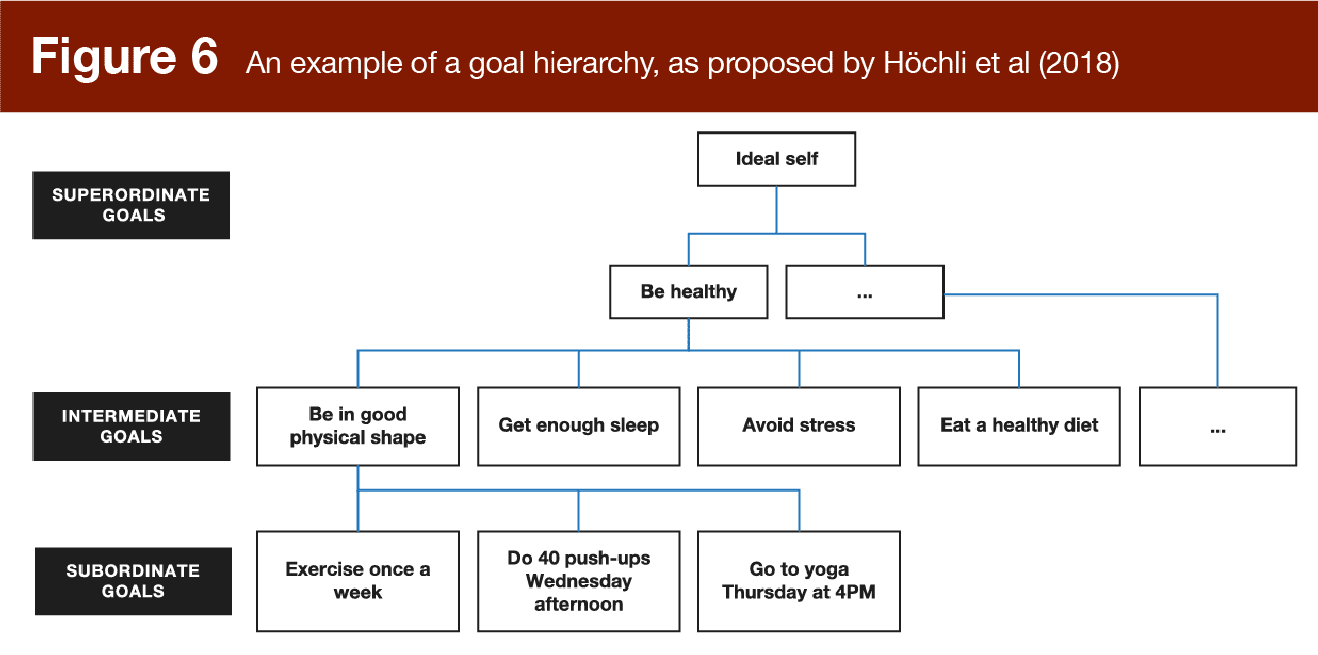
When somebody tells me they need to hit a sure body-fat share by a given date, my first response is to ask them why. Not a superficial clarification of their purpose, however a deeper description of why they worth health and why their health targets are so essential to them. This normally leads them to a superordinate purpose that anchors their purpose hierarchy. Subsequent, we want an intermediate purpose. As I famous close to the start of this text, a body-fat share is sort of by no means the “actual” purpose. Typically, body-fat share is standing in as a proxy for a extra particular efficiency purpose, physique purpose, or well being purpose. When formulating this into an intermediate purpose, I favor to make it process-oriented each time doable. For somebody with a physique-focused purpose, a process-oriented purpose may be to lose roughly one pound per week till reaching their desired stage of muscular definition. Notably, this intermediate purpose describes the trail and the method (i.e., establishing and sustaining a deficit that facilitates one pound of weight reduction per week) quite than the cumulative end result of implementing the method for a given period of time (i.e., shedding a certain quantity of complete weight or fats). Lastly, you’ll need to assemble a collection of subordinate targets to assist your intermediate purpose. That is the place you apply the numerous methods mentioned in earlier MASS articles – particular methods pertaining to resistance coaching, cardio, non-exercise bodily exercise, power consumption, protein consumption, meal timing, and so forth. In different phrases, you map out the methods which can be going that can assist you create the caloric deficit wanted to lose a few pound per week.
When you had set a purpose to succeed in a selected body-fat share by a sure date, you’d run into plenty of challenges. First, your purpose is most definitely a proxy for one thing else that’s extra significant to you. Second, you received’t actually know your beginning body-fat share, nor will you be capable of confidently affirm that you just really reached your meant body-fat share ultimately. Third, will probably be troublesome to find out how a lot weight you must lose alongside the way in which, as will probably be immensely troublesome to foretell how a lot lean mass you’ll acquire or lose alongside the way in which. Fourth, in case you begin falling in need of your deliberate tempo of weight reduction, you’ll have to begin shedding pounds quicker than your authentic place to make up for misplaced time. Fifth, you’ll most likely have a reasonably dangerous time, which is commonly the case for outcome-oriented targets which can be approached with inflexible cognitive restraint. As a substitute, I hope you’ll take into account the choice – a process-oriented purpose with a versatile timeline that’s anchored by a well-aligned purpose hierarchy that provides that means to your pursuit.
Get extra articles like this
This text was the duvet story for the January 2024 subject of MASS Analysis Overview. When you’d prefer to learn the complete, 92-page January subject (and dive into the MASS archives), you’ll be able to subscribe to MASS here.
Subscribers get a brand new version of MASS every month. Every subject contains analysis overview articles, video displays, and audio summaries. PDF points are normally round 100 pages lengthy.
References
- van Marken Lichtenbelt WD, Hartgens F, Vollaard NBJ, Ebbing S, Kuipers H. Body composition changes in bodybuilders: a method comparison. Med Sci Sports activities Exerc. 2004 Mar;36(3):490–7.
- Trexler ET, Hirsch KR, Blue MNM, Mock MG, Smith-Ryan AE. Estimating body composition at baseline and tracking changes during weight loss: Validity of common methods in comparison to a criterion four-compartment model. J Int Soc Sports activities Nutr. 2017 Sep 12;14(2):31.
- Helms ER, Zinn C, Rowlands DS, Brown SR. A systematic review of dietary protein during caloric restriction in resistance trained lean athletes: a case for higher intakes. Int J Sport Nutr Exerc Metab. 2014 Apr;24(2):127–38.
- Murphy C, Koehler Ok. Energy deficiency impairs resistance training gains in lean mass but not strength: A meta-analysis and meta-regression. Scand J Med Sci Sports activities. 2022 Jan;32(1):125–37.
- Hickson RC. Interference of strength development by simultaneously training for strength and endurance. Eur J Appl Physiol. 1980;45(2–3):255–63.
- Helms ER, Prnjak Ok, Linardon J. Towards a Sustainable Nutrition Paradigm in Physique Sport: A Narrative Review. Sports activities. 2019 Jul 16;7(7):172.
- Kaftan OJ, Freund AM. The Way is the Goal: The Role of Goal Focus for Successful Goal Pursuit and Subjective Well-Being. In: Diener, E; Oishi, S; Tay, L. Handbook of Nicely-Being. Salt Lake Metropolis, UT: DEF Publishers.
- Höchli B, Brügger A, Messner C. How Focusing on Superordinate Goals Motivates Broad, Long-Term Goal Pursuit: A Theoretical Perspective. Entrance Psychol. 2018;9:1879.
